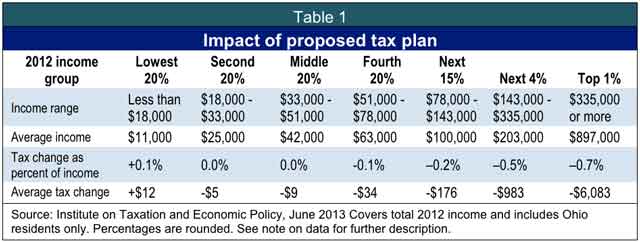Heading into state budget season this year, Ohio Gov. John Kasich put forth a plan that he said would cut income taxes for everyone in the state – including businesses – while raising sales tax revenues and the state’s severance tax on fracked oil and gas. At the end of the process, and after several months of back and forth between Republicans in the House and Senate, Kasich got tax cuts but some observers are questioning GOP claims that everyone is a winner after this process.
An across the board cut of 10 percent will come off of Ohioans’ personal income tax bills and small businesses will receive a new state income tax exemption of 5o percent on the first $250,000 of business income. The personal income tax cut will be phased in over three years. Tax cuts in the Kasich budget total around $2.7 billion. They are being paid for by raising the state sales tax one quarter of a percent to 5.75 percent, new taxes on many online purchases, cutting the 12.5 percent state pickup on the cost of new local property tax levies and means testing the state’s homestead exemption for older Ohioans.
Two agricultural wins are increased funding for the Ohio Agricultural Research and Development Center in Wooster and the Ohio State University Extension program.
Even with gerrymandered, one-party rule in Columbus, the process behind the state’s budget bill (HB 59) lived up to the old saw about lawmaking’s resemblance to sausage making. At the eleventh hour in the House-Senate conference committee where the two versions of the bill were being reconciled, the final tax plan took form. While income tax cuts had always been on the table, the state abandoning its decades-long practice of picking up 12.5 percent of the cost of local property tax levies was a surprise. Coming just days before the two chambers voted on final passage, there was no opportunity for public testimony, nor the time for organized opposition.
School levies will be hit hardest by the state’s ending this support as local boards of education will realize that the money which needs to be raised locally will now increase even further than it has after the state cut nearly $2 billion from public education in the last budget. While this budget restored some of those funds, it contains $514 million less in state education aid than the last state budget under former Gov. Ted Strickland. Only time will tell whether local districts (and local property tax payers) will adjust to yet another cut in state support for public education.
Rep. Lynn Wachtmann (R-Napolean) summed up the views of many GOP legislators during floor debate on the budget last Thursday.
“When government has less of my money, or my constituents’ money, we have more freedom,” he said.
On the other hand, House and Senate Democrats called the overall package of tax cuts and tax increases “regressive.” Although there was little time to analyze the plan, Policy Matters Ohio and the Institute on Taxation and Economic Policy released a short study one day before the vote which found that Ohio’s top 1 percent of income earners will receive an overall tax cut over $6,000. The study showed the middle 20 percent of income earners will get a $9 tax cut (also known as lunch at McDonald’s) while the lowest 20 percent of incomes will actually pay $12 more.
While increased severance taxes were on the table early in the budget process, Kasich’s proposal was shelved in the House and not revived by the Senate. GOP House and Senate leaders have signaled that there may be a bill later this year to revisit this issue. Kasich approached the legislature with a revamped severance tax plan which would have left some of the receipts in Appalachian Ohio where the drilling is occurring. The Ohio Farmers Union supports increasing the state’s severance taxes and setting aside a portion of receipts for the counties where the taxes are collected and for environmental mitigation.
Another issue which won’t go away with this budget’s passage is Kasich’s desire – which polls show is widely supported throughout Ohio – of accepting the federal expansion of Medicaid which is part of the Affordable Care Act. The federal government will pick up 100 percent of the cost for the first few years of the expansion and 80 percent of the cost thereafter. Nearly 300,000 Ohioans currently without medical coverage would come into the system. This was also a provision which was taken out of the budget in the House. Efforts are underway to fashion a Medicaid “reform” bill which would authorize the expansion while fixing some of the problems in Ohio’s Medicaid program. Since the current legislative session is in recess for the summer, it appears that the earliest such a bill could surface is this fall.



Leave a Reply